Raytheon Coyote interceptor drones and air defense systems based on them
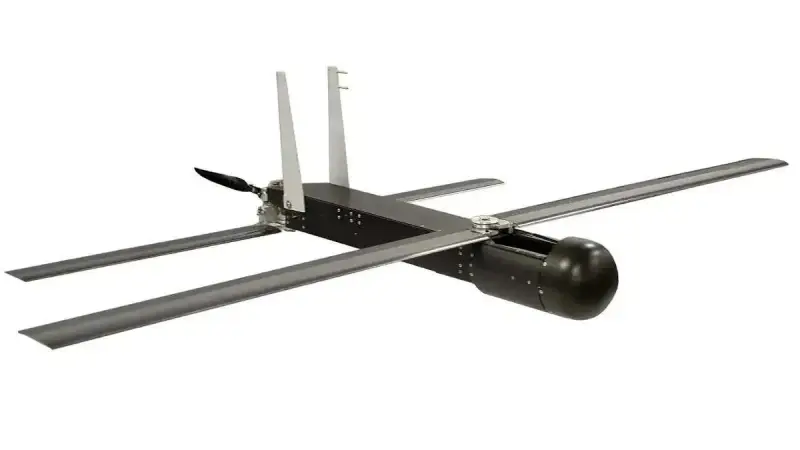
Coyote Block 1 UAV in flight configuration
The Pentagon continues to search for promising air defense systems capable of effectively combating unmanned aviation enemy. It is planned to adopt and purchase various complexes and systems with various capabilities. In particular, it is planned to purchase a large number of Raytheon Coyote unmanned interceptors of two modifications with different features and functions.
Unmanned platforms
In 2007, Advanced Ceramic Research from Arizona developed and tested a lightweight multi-purpose UAV, Coyote. The drone, weighing less than 6 kg, was positioned as a universal platform for mounting and using various payloads and performing various missions. In addition, several other platforms with different characteristics were introduced during that period.
At the end of the 2015s, Advanced Ceramic Research changed ownership. Then it changed hands several more times until it became part of Raytheon Missile & Defense in XNUMX. As a result of this, existing and promising developments, including the Coyote UAV, received a chance for further development and mass production.
Already in 2015-16. Raytheon, commissioned by the Pentagon, began developing combat modifications of the existing UAV. It was proposed to turn the Coyote Block 1 product into a loitering munition, as well as make it an interceptor for others drones. Both modifications of the UAV have been tested and generally attracted the interest of a potential customer in the US armed forces.
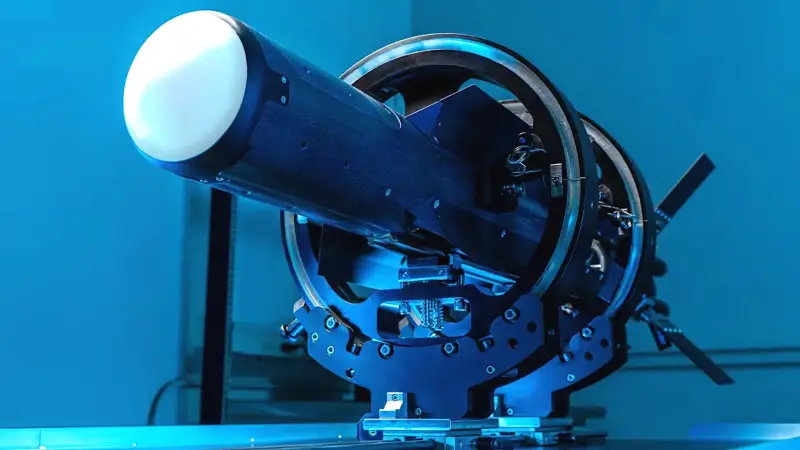
Coyote Block 2
By 2017-18 Based on the Coyote, an anti-aircraft complex called Howler C-UAS was created in two versions, designed to intercept UAVs. Then he went into production and began entering units of the ground forces and the Marine Corps. By mid-2019, the complex reached the stage of initial operational readiness.
By this time, Raytheon had developed a new project, Coyote Block 2. Despite retaining the name and some technical developments, it was actually a new UAV with a different design and characteristics. It was also considered as a multi-purpose platform, and integration into the Howler C-UAS complex was being worked out. In February 2020, the Pentagon issued a contract for the production and delivery of the first batch of new interceptor drones.
Since the beginning of 2021, the next UAV in the series, Coyote Block 3, has been developed. In its design, it is similar to the basic Block 1, but differs in increased dimensions, equipment, etc. This time, the customers include the US Navy, which wants to receive a drone with the ability to launch from sea platforms - for reconnaissance or strikes. To date, the third version of “Coyote” has entered testing and is demonstrating its capabilities.
Supply contracts
The first customer of the Coyote product back in the late XNUMXs was the National Oceanic and Atmospheric Administration under the US Department of Commerce. It uses UAVs to study the atmosphere and collect the necessary data. To obtain maximum results and save energy, drones are delivered to the desired area using carrier aircraft and launched at a given altitude.
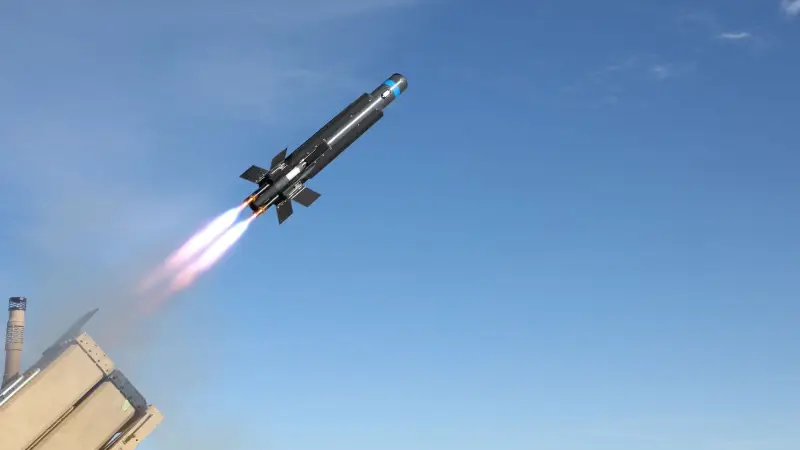
Launch of the second version of "Coyote"
The Howler C-UAS air defense system for the Pentagon is being mass-produced, but production rates remain low. According to various sources, only a few dozen such systems and hundreds of Coyote Block 1/2 UAVs for them have been delivered. The third version of the drone is still being tested and is not ready for mass production. However, the armed forces are already planning to purchase it and put it into service.
On December 18, the Pentagon published information on a future government order for the supply of UAVs and other equipment. In the near future, he wants to receive an offer from the only possible supplier, Raytheon, after which the terms will be discussed and an agreement will be concluded.
According to the request of the military department, it is required to supply 6 thousand Coyote interceptors with kinetic weapons and 700 units. with a different combat load. We are talking about drones of the last two models. They will also order 252 stationary and 25 mobile launchers. 118 stationary KuRFS-type radars and 33 mobile ones will be used with this equipment.
The contract for the supply of all this equipment will appear in the near future, and several years will be allocated for its implementation. The first batches of ordered products are expected in 2025, and the last ones will arrive in 2029. It is reported that the bulk of the new complexes will be operated in the continental United States. Deployment to overseas bases is also planned, but details have not been specified.
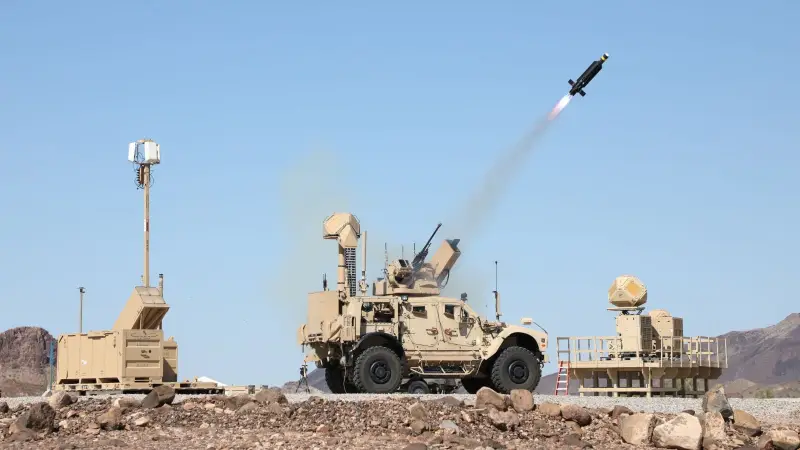
Self-propelled (in the center) and stationary versions of the Howler C-UAV complex. M-LIDS machine launches a UAV
It is curious that ground-based systems and unmanned interceptors have already become export goods. In November 2022, Qatar ordered 10 stationary air defense systems with Coyote Block 2 unmanned interceptors. The contract provides for the supply of 200 drones of this type.
Technical aspects
The Coyote Block 1 product was a folding aircraft with minimal dimensions. A cylindrical fuselage was used, to which two wings of different spans were hinged, as well as a pair of fins. The total length of the product in flight configuration was 910 mm, the wingspan was approx. 1,5 m. Starting weight – 5,9 kg. The device was equipped with an electric motor with a pusher propeller. The maximum speed reached 130 km/h, the maximum launch altitude was more than 9 km. The UAV could remain airborne for an hour; remote control range – 93 km.
The project involved the use of a remote control system and made it possible to equip the UAV with different types of loads. Thus, the interceptor modification received a low-mass fragmentation warhead; a similar load was carried by loitering air-to-surface munitions.
In the Coyote Block 2 project, the cylindrical fuselage and general layout were retained, but the folding wings were replaced with X-shaped planes of low aspect ratio, and stabilizers of a similar design appeared in the tail. The electric motor was replaced with a compact turbojet engine and supplemented with a solid fuel starter.
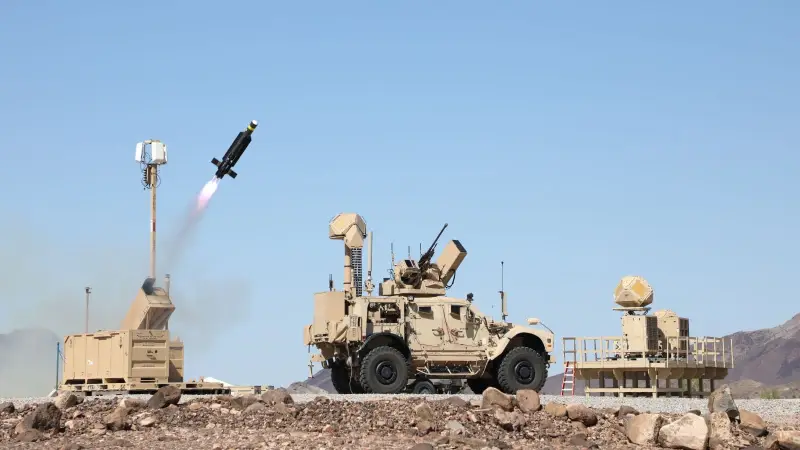
UAV launch from a stationary launcher
The second version of the “Coyote” retained remote control and received an optical and radar surveillance system. Also, a fragmentation warhead was again used. At the same time, they developed and implemented a “non-kinetic” version of combat equipment in the form of a source of interference - this version of the UAV should suppress the target’s communication channels and exclude its further operation, or help the operation of other air defense systems. The range when launched from a ground platform is up to 15 km.
The Coyote Block 3 product is made on the basis of developments from two previous projects. A glider similar to the first modification is used, characterized by increased dimensions. The electronics and combat equipment, in turn, are based on the Block 2 project. It is reported that the third version of the Coyote, unlike the previous ones, is returnable. When using a “non-kinetic” warhead, the device can return for restoration and new use.
As part of the Howler C-UAS complex, Coyote series drones are used with unified launchers. They are rectangular blocks with vertical guidance devices, having two or four guides for UAVs.
The Howler also includes the KuRFS radar from Raytheon. It includes an antenna device with four phased arrays, providing visibility of the entire upper hemisphere. The detection and tracking range depends on the type of air target and reaches tens of kilometers. The ability to detect and track plastic UAVs and metal objects the size of a bullet is declared. The radar antenna is mounted on a telescopic mast.
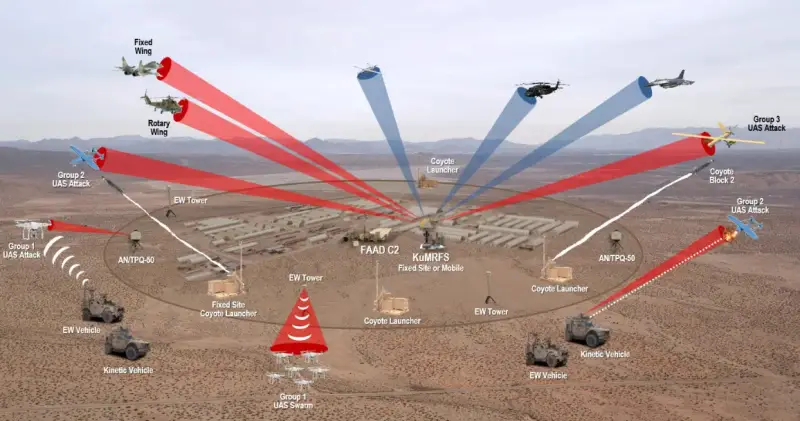
Organization of area air defense using Coyote UAV
The Howler C-UAS complex is available in two versions - mobile and stationary. The mobile version, M-LIDS, is built on the basis of a JLTV vehicle or other platform with sufficient carrying capacity. The launcher for interceptor drones is mounted on a standard turret, and a mast with a radar antenna is placed on the aft platform. A similar vehicle with a radio intelligence system and a jamming station has also been developed.
The stationary complex FS-LIDS has the same facilities, but differs in layout. The radar and other electronics are on a separate platform, and the launcher is placed in a container. These means can be located at a distance from each other and combined as necessary. Thus, one radar can serve several launchers. At the same time, the FS-LIDS components do not differ in parameters and capabilities from the M-LIDS tools.
Drone vs drone
Thus, the search for effective means to combat small-class UAVs continues in the United States. Various solutions are being proposed, and some of them even reach the point of being used by the military - as has already happened with the Raytheon Coyote series of unmanned interceptors. Moreover, these products performed well, and the Pentagon decided to expand purchases. By the end of the decade, he wants to receive a large number of ground-based air defense systems and thousands of ammunition for them.
Considering the volume of the future order, we can expect that Coyote-based air defense systems will become the main means of the US Army for combating enemy drones in the foreseeable future. At the same time, the Pentagon is unlikely to limit the development of this area, and new complexes for this purpose should appear in the future. And it is very likely that they will also intercept small targets using UAVs.
Information